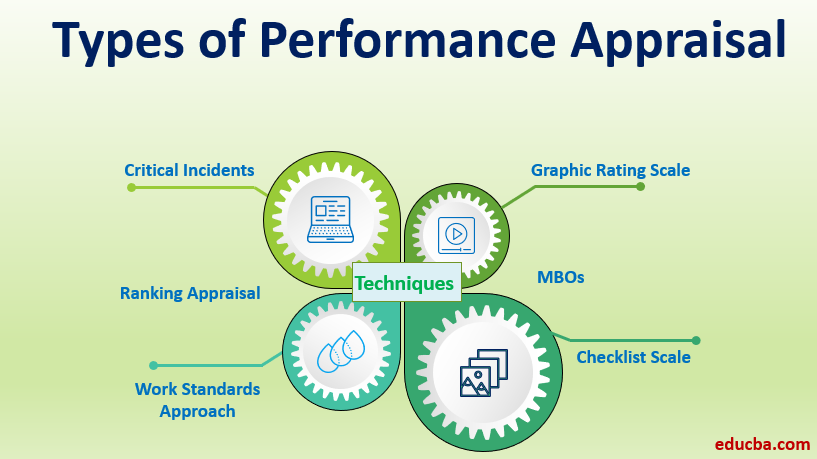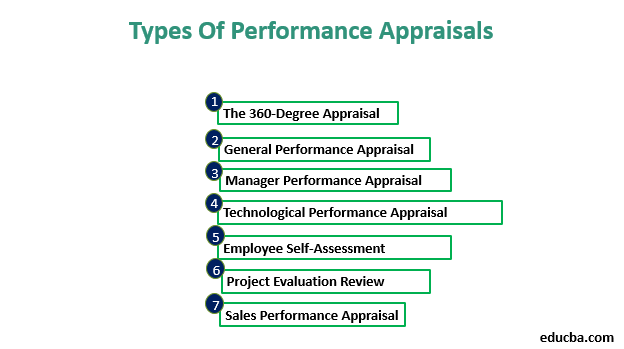
Introduction to Types of Performance Appraisal
The following Article Types of Performance Appraisal offers a comprehensive overview of the kinds of performance appraisal. Performance is defined as the application of knowledge, skills, and abilities at one’s disposal to finish off a particular work. The way an individual scores at the end on the basis of the job responsibilities that s/he is into. Job performances are of two types: contextual and task. Task performance relates to the sense of cognitive ability, while contextual performance is related to personality. Williams and Krane identified certain features that define the state of ideal performance.
- Risk-taking ability
- Not being performance-oriented
- Focusing on work
- A sense of self-confidence
- A sense of adapting to various situations
- A sense of time and space management without affecting the work
Motivation, task-relevant attention, positive self-talk, and cognitive regulation are other related factors. Crisis handling, stress management, problem-solving ability, possessing proper skills, agile management, adapting to situations, and fitness of the body are the eight factors that determine an individual performance.
Types of Performance Appraisals
Managers are not very much in favor of performance appraisal techniques, but still, it is required to have the knowledge of various performance appraisal techniques so that we get to choose the best possible option in the time of need. Here are a few different types of appraisal methods:
1. The 360-Degree Appraisal
This method involves giving out a questionnaire with questions regarding a colleague’s performance they need to fill it up. The manager can consider this feedback by evaluating the performance at the end of the quarter/year.
2. General Performance Appraisal
This method involves continuous interaction between the employee and his manager, continuous setting of goals and achieving them. Whether the employee has been able to do justice the entire process or not is evaluated at the end of the year.
3. Technological/Administrative Performance Appraisal
This appraisal technique concentrates on technical more than any other aspect of performance on the job as the employees involved have specialized skills. They’re judged on the skills they possess and the activity they complete.
4. Manager Performance Appraisal
A manager’s performance should also be appraised, and this includes not just his/her performance on the job but also relationship management with clients at his/her disposal. Generally, anonymous feedback forms are received, which are then considered for appraisal.
5. Employee Self-Assessment
This method is very unpopular among employees as nobody can deal with rating himself or herself. The self-assessment sheet is compared with the one filled up by the manager and the differences are discussed.
6. Project Evaluation Review
This method involves performance appraisal of the team members involved at the end of every project and not at the end of every year. This helps the team and its members develop with each passing project.
7. Sales Performance Appraisal
A salesperson is evaluated on the basis of his/her sales skills and accomplishment of financial goals set previously. Goals set in case of sales should be realistic and ways of achieving them should be decided by the employee and the manager concerned.
Performance Appraisal Techniques
Below are the different techniques of Performance Appraisal:
Graphic Rating Scale
- A graphic rating scale rates employees on a fixed scale as per the qualities they are required to possess. The final score obtained classifies employees into various tiers and helps in their performance evaluation at the end of the year. It is understandable and easily usable. Behaviors can be quantified, and appraisal can be simplified using this method.
- There are demerits to this method too. Temperament varies from person to person. A few evaluators can be very strict, and a few can be very lenient based on their fixed agenda. Though it helps to identify the best and the worst performing individuals, it does not separate average individuals.
Essay Performance Appraisal Method
- It is also called the “Free Form method.” It includes a fact-based performance description of employees with instances to support it, and based on this; the s/he is evaluated on the job.
- It is a qualitative technique and not a quantitative technique. So, evaluation using this method is difficult. Moreover, one needs to have detailed knowledge regarding the job and the firm in order to use this method.
Checklist Scale
- A checklist is prepared on the basis of Yes or No with regard to the traits of an employee. If an employee has a particular trait, then it is marked as yes or else no. The evaluation of the rater and the actual HR evaluation are two separate things altogether, and it is not a detailed evaluation.
Critical Incidents
- The manager has to prepare a list of important incidents highlighting the behavior of an employee. These incidents help decide the best or the poorest behavior of an employee, and s/he is evaluated. The only disadvantage of this method is it can be very biased.
Work Standards Approach
- The management of a firm establishes fixed standards and the final deliverable prepared by the team involved has to be as per those points, and then, each member is evaluated. So, the employee knows his/her job and its terms clearly. It just does not help in making individualistic appraisals.
Ranking Appraisal
- A manager is required to rank employees put into the same job and then evaluate them. The employees are ranked chronologically in either increasing or decreasing order. The problem is it cannot be used on a very large team and its members.
MBOs
- MBO (management by objectives) involves setting objectives for the employees on the job, which they have to accomplish and are further appraised on that basis. SMART Goals i.e.goals that are Specific, Measurable, Actionable, Relevant, and Time-bound are set so that biased can be prevented.
Conclusion
Performance appraisal is generally perceived as something very dangerous by employees in an organization. So, it is necessary to opt for the right methodology to get the correct results. The methodology we opt for should provide some kind of value to the firm as well as the employees and managers. It is also important to pursue these methods as we should know if our profound objectives are being met and, if they are, then to what extent.
Recommended Articles
This is a guide to Types of Performance Appraisal. Here we discuss the techniques of performance appraisal as well as its various types with detailed explanation. You can also go through our other suggested articles to learn more –


